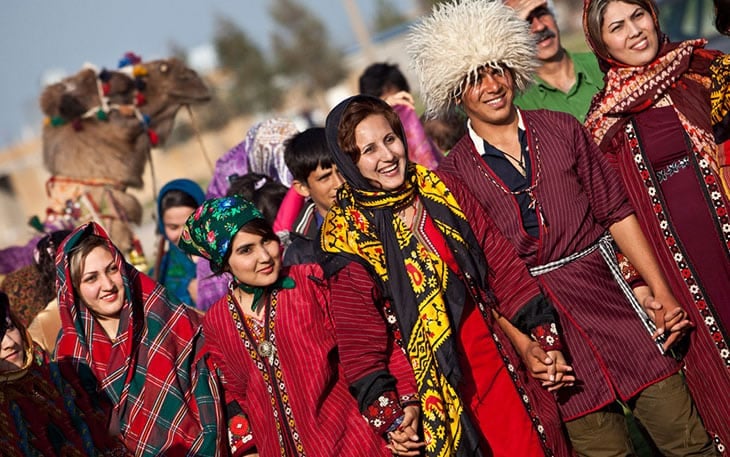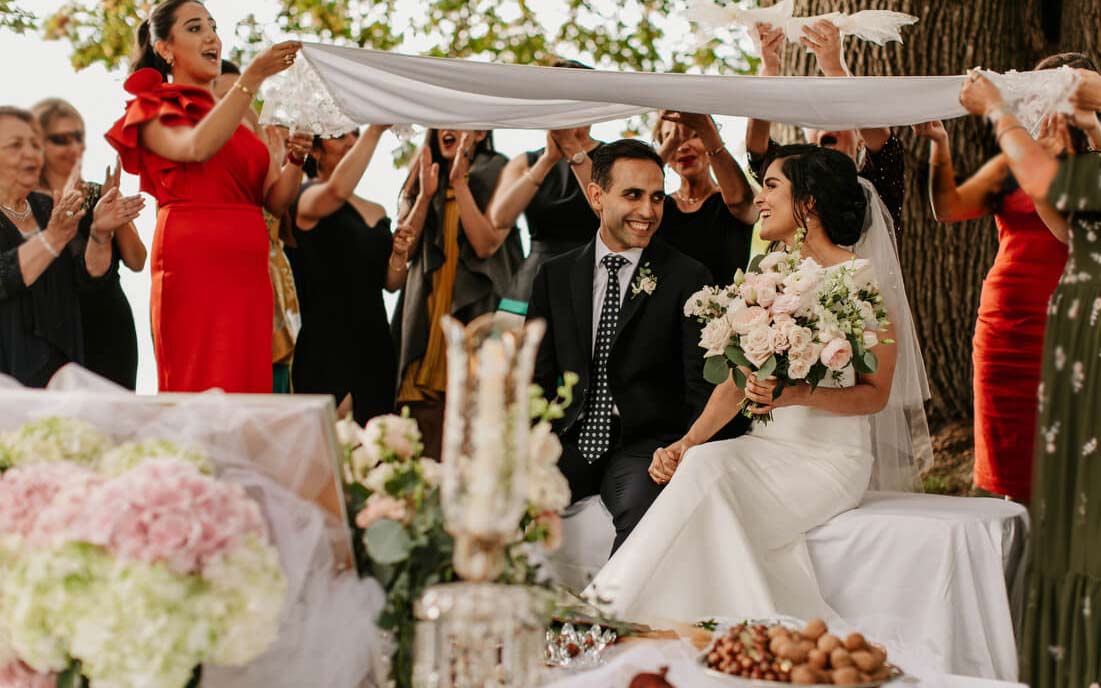How Are Iranian Weddings?

Marriage is a big thing in Iran. While it tends to be less and less traditional in big cities, weddings in Iran remain a very important tradition for Iranian families. So much so that celebrations can last up to one week in some regions.
Relationships between men and women are among these things that at the first glance may appear quite similar to western countries. Yet, when taking a closer look, one can see many differences. The importance of marriage is one of these.
In these past decades, the average age for getting married has kept being pushed forward. It’s not unusual for people in their twenties not to want to get married, but around their thirties, the time usually has come.
As men and women cannot live under the same roof without being married, it’s understandable that most people eventually wish to get married. That’s usually the main reason that motivates young people to get married.

It is also pretty rare to find any parents that do not wish for their child to get married. In many cases, marriage is the moment from which the child leaves the house, to start having his or her own family (even though many young Iranians are now living independently in big cities, the country’s economic situation makes it hard and not accessible to all).
But weddings in Iran are not just the business of two persons, the bride and the groom: it is about two families creating links. That’s why it is rare that someone would decide to marry a person if their family is against this idea (either because the two families don’t get along well or because the choice of the bride/groom is disapproved by the parents). The fact that marriage is first a family matters explains why until recently, there used to be a lot of arranged marriages in Iran, as it was more a reasonable choice than a choice of the heart. Yet, this has become less common nowadays and most husbands and wives usually choose each other.
Contents
The first steps: “khastegari” and “bale boron”

Modern and traditional marriages always start with the same stages. The first one is a ceremony known as “Khastegari”. It consists of the man asking for the consent of the woman’s family. That can be done in a traditional way or with something modern and almost informal. In theory, the family of the groom goes to the bride’s house, so that the two families can get to know each other and discuss their child’s marriage. Usually, only the father and mother are present, but sometimes the grandparents are also attending.
During that ceremony, the two families get to know each other, and the groom can meet the bride alone for a few minutes, sometimes for the first time (which is quite rare now). But that doesn’t always happen. In a more conservative context, the potential bride would just look at the ceremony, hidden. Yet, in these more traditional societies, the potential bride usually knows the groom as if it would be someone from her village or a relative (cousins can get married in Iran).

If at the end of the meeting, the families agree on a wedding, it leads to another ceremony called “Bale Boroon”. It is done more and more in an informal way and takes place at the bride’s family house. The goal is that the two families gather to get to know each other, but this time with more family members (cousins, aunts, etc.). On that occasion, people bring gifts to the bride, including one of the most important: the wedding ring!
This is also when the “mehrieh” is discussed. In Iran, the bride is supposed to provide dowry. On the other hand, the tradition wants that she benefits from a “mehrieh”. The mehrieh is an amount determined in advance and measured in gold coins, that the husband has to pay to the wife in case of divorce. Given the difficulties that a woman can face after a divorce in Iranian society, this is still a very serious topic even in modern cities, and it is legally registered with the marriage. Yet, in some regions of Iran that tradition doesn’t exist; rather, it’s the groom’s family that pays for the wedding ceremony and provides the bride with some kind of trousseau.
“Aghd”, between engagement and real marriage

Once the marriage and its conditions are decided, it is time to officialize it. The Aghd ceremony somehow looks like an engagement party, yet it is also when the marriage becomes official. This is both a religious and legal ceremony that is presided over by a Mullah.
The Aghd ceremony is limited to close family members. Most of the time, the celebrations are not mixed, and the only man attending is the groom (yet, this is not always the case). During Aghd, the Mullah reads verses of the Quran before asking for the consent of the bride, three times. After the third time, the bride can say the expected “yes”. After which, the consent of the groom is asked (once only, though!).
One of the important items of Aghd is the “soffreh”. This is a table that must contain different foods and decorations. There must be for instance pastries, fruits (that symbolize fertility), but also a mirror and two candles, the Quran, and gold coins.
The “aroosi”, the true wedding ceremony

It’s enough to see how many songs are made about “aroosi” to understand that this is a big thing for Iranians. A wedding ceremony is usually huge! Of course, it has changed a lot during the past decade with traditions fading away and also due to the cost of such weddings.
Nowadays, modern weddings like the ones that take place in Tehran consist of one big evening of festivities. The whole family is invited along with friends, which can easily make several hundreds of guests. The ceremony usually takes place in a wedding hall or garden. Aroosi ceremonies have food, sweets, and more importantly dancing: no matter how young or old are the people who attend the wedding, you can expect them all to dance all night long!
At the end of the evening (or the night), and similarly to many countries’ customs, the bride and the groom leave the place in a car decorated with flowers, to be escorted to their house with the sounds of other car’s horns.
Traditional weddings in Iran

In many regions of Iran, weddings (the “aroosi” part) are held according to local traditions. The henna night (“hanna bandoon”) is one of these local traditions, that is also common to many Sunni Muslim regions. It’s a night that is dedicated to putting henna on the hands and feet of the groom and the bride. This is usually one of the important nights.
Because indeed, in many traditional areas, weddings are not just a one-night event. Rather, it can last three, four, five, and even up to seven days! Weddings taking place in Hormozgan (south of Iran) are among the most impressive in Iran. It usually starts with a first night called “Shab-e Sâkht”, during which the women of the groom’s family bring to the bride her trousseau (clothes, cosmetics, and other things she will need). That night is then followed by the henna night. Followed by one or two nights of dance, with live music performed. On the last day, the groom is prepared by the men of his family (shaved and bathed), so that at night, they take him to the bride’s house, where they will stay together.
They will live for a while in the “hedjle”, a room (usually at the bride’s family house) fully decorated with bright colors and numerous mirrors.
All these nights include a lot of music and dancing. But keep in mind that in traditional areas, men and women are celebrating in separate places. Legally, mixed wedding ceremonies are not authorized, even though some people can still manage to do them. In Kurdistan, which is also famous for its huge and colorful weddings with traditional dances, it is rare for men and women to be separated. There too, wedding ceremonies used to last for 7 days, but it is nowadays common that it be only one or two days.

